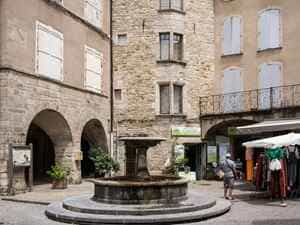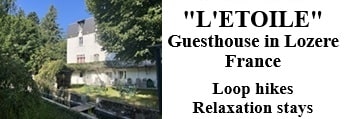      |
90km bike tour at La Bastide-Puylaurent
|
      |
From l’Etoile, head towards the centre of the village, then take the direction of Villefort opposite. Continue to the Pradillou roundabout, then follow the D4 straight on for 16.5 km to the Col du Chap del Bosc, passing through Saint-Laurent-les-Bains and the Ceyrou bridge over the Borne (beautiful spots for swimming in granite pools). When you reach the pass, continue straight on the D4 towards Peyre. Then turn right onto the D10, passing through the villages of Trouillas, Seyras, les Sielves and Chambonas. Cross the bridge over the Chassezac to reach Les Vans. Take the D901 towards Villefort for 1.8 km, then turn right onto the D113. Cross the bridge over the Chassezac, then turn left to stay on the D113, following the river to Sainte-Marguerite-Lafigere and Pied-de-Borne. At Pied-de-Borne, turn right onto the D151 towards Alzons, passing through Pantostier, Les Baumes and Chalbos. 500 metres after Alzons, leave the D151 and go down towards the bridge over the Borne, then continue towards Nicoulaud. Then turn left onto the D573 to reach the Pradillou roundabout via Les Fagoux. Finally, turn left towards La Bastide.

20,5km - 25km - 27,7km - 30km - 35,2km - 37km - 41,5km - 44km - 48,4km - 57,5km - 59,4km - 60km - 60,5km - 69km - 70km - 76,8km - 77km - 81km - 90km - 95,7km
Electric bike rental
Google Maps - Google Earth - GPX







 Distance: 90km. Maximum altitude: 1167m. Minimum altitude: 140m. Cumulative elevation: 3148m.
Distance: 90km. Maximum altitude: 1167m. Minimum altitude: 140m. Cumulative elevation: 3148m.
IGN maps: La Bastide-Puylaurent (2738E). Largentiere la Bastide-Puylaurent Vivarais Cevenol (2838OT). Besseges Les Vans Chassezac Valley (2839OT).
Print the route - Electric bike rental
Vivarais, located in the current department of Ardeche, is a former province of the Kingdom of France, marked by a rich history and a strong cultural identity. Anchored in the Massif Central between the Cevennes and the Rhone Valley, the region has long been influenced by the power of the Church, with the diocese of Viviers becoming an important religious center from the 4th century. In the 16th century, Vivarais was a major center of the Protestant Reformation and the Wars of Religion, particularly in Privas, a Huguenot stronghold. These conflicts left deep scars, particularly with the persecution of the Protestant community following the revocation of the Edict of Nantes in 1685, leading to exoduses and tensions. The economy of Vivarais is historically based on agriculture, livestock farming and the silk industry, which prospered in the 17th and 18th centuries thanks to sericulture and weaving, although this activity declined in the 19th century due to diseases and industrial competition. Vivarais is also distinguished by its varied landscapes, from volcanic mountains and plateaus to river valleys, which today attract nature tourism enthusiasts. The Ardeche gorges and their prehistoric caves, including the Chauvet cave, are world-renowned sites.
Chambonas is a small commune in Ardeche, in the Auvergne-Rhône-Alpes region, renowned for its historical heritage and peaceful natural setting, popular for activities such as swimming, fishing and canoeing in the Chassezac River. Dominated by an imposing 14th-century castle, listed as a historic monument, the village is marked by the history of the La Garde family, who contributed to its development from the Middle Ages. The medieval castle, modernized in the 16th and 17th centuries with a French-style park and new terraces, stands as an emblem of the region, although closed to the public. Chambonas is part of an ancient network of mule routes linking Les Vans to Puy-en-Velay, a commercial and strategic axis for silk, wine, and cereals between the Mediterranean lowlands and the Velay mountains. This network contributed to local prosperity, notably through the rise of mills and inns, and allowed the La Garde family to acquire a solid fortune. The importance of Chambonas as a crossing and trading point was reinforced by its royal fairs, instituted by Charles VII. The La Garde, initially supporters of the Reformation, also played a role in religious and economic relations between the Protestant communities of Ardeche. During the reign of Louis XIV, the castle was embellished with a gate and a garden that added a touch of pleasure residence to the initial medieval structure, making Chambonas a leading historical and cultural site in the region.
Les Vans, located in Ardeche in the Auvergne-Rhône-Alpes region, is a historic commune nestled in the heart of the Chassezac River basin and at the foot of the Serre de Barre. It is a part of the Monts d'Ardeche Regional Natural Park and the peripheral zone of the Cevennes National Park, benefiting from a Mediterranean climate. The region has been inhabited since prehistoric times, with remains such as decorated caves and dolmens. In Gallo-Roman times, a Roman road crossed the commune, and in the Middle Ages, Les Vans developed around the Saint-Pierre church under the influence of the Abbey of Saint-Gilles-du-Gard. The leather and wineskins trade as well as the medieval ramparts mark this period. The religious wars disrupted the town in the 16th century, which adopted the Reformation. The Saint-Pierre church was destroyed then rebuilt in the 17th century with a baroque style and an altarpiece donated by Abbot Claude de Roure. In the 18th and 19th centuries, Les Vans prospered thanks to agriculture and trade, becoming a cantonal capital. The arrival of the railway reinforced its dynamism, accompanied by numerous public facilities. The town has varied landscapes between mountains, plateaus, and limestone forests such as the Païolive wood, where paths allow you to explore strange rock formations and dizzying cliffs. Among the remarkable sites, the old village of Thines, perched and with a sandstone church, as well as the Banne castle and the Jales commandery bear witness to its rich past. Les Vans is also a centre of culture and heritage with the Saint-Pierre church, the Sainte-Philomene chapel and several museums. Its weekly market, renowned for its local produce, attracts visitors who come for the local wines, oils and cheeses. This mix of historical heritage and natural landscapes makes it a popular holiday destination and a starting point for many excursions.

Former holiday hotel with a garden along the Allier, L'Etoile Guest House is located in La Bastide-Puylaurent between Lozere, Ardeche, and the Cevennes in the mountains of Southern France. At the crossroads of GR®7, GR®70 Stevenson Path, GR®72, GR®700 Regordane Way, GR®470 Allier River springs and gorges, GRP® Cevenol, Ardechoise Mountains, Margeride. Numerous loop trails for hiking and one-day biking excursions. Ideal for a relaxing and hiking getaway.
Copyright©etoile.fr








 Distance: 90km. Maximum altitude: 1167m. Minimum altitude: 140m. Cumulative elevation: 3148m.
Distance: 90km. Maximum altitude: 1167m. Minimum altitude: 140m. Cumulative elevation: 3148m.